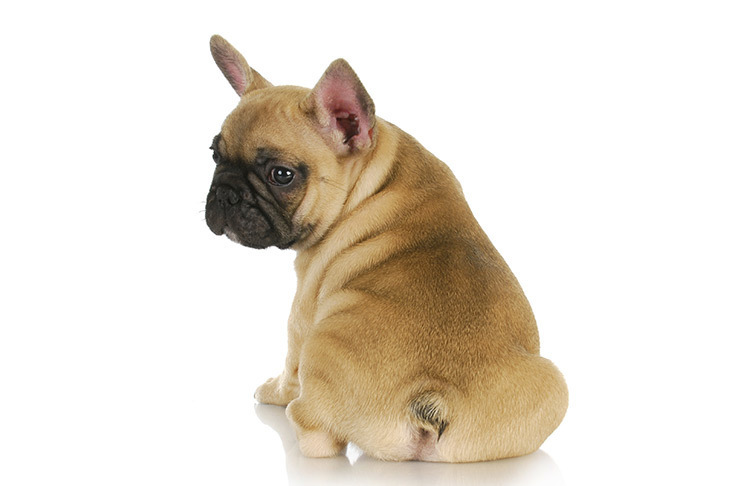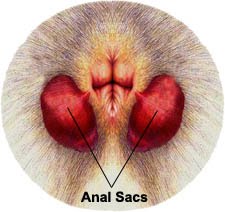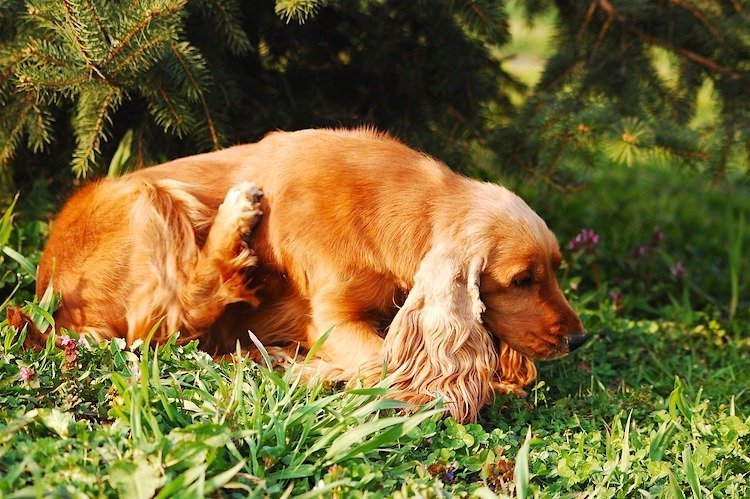
The boss has finally agreed to join you for dinner, and this is your big chance to impress and secure that promotion. Horror of horrors, right between Mains and Dessert, Scooter proceeds to make a grand entrance and rub his rear end up and down the carpet right next to Mr Factor’s polished brogues. He must surely need to be dewormed, right? Scooter, that is, not Mr Factor…
It’s a common conclusion when a dog scoots that worms must be at the bottom of it. While internal parasites may well cause itching and discomfort, there could be a variety of other reasons for scooting.

Dogs have a pair of anal glands inside their rectum, which are responsible for producing, storing and expressing fluid onto the faeces when your dog passes a stool. It might not make for the best dinner party conversation, but anal gland problems are common, often leading to discomfort and scooting.
The fishy-smelling fluid produced in the anal sacs is what animals use to scent mark. The normal process of defecating puts pressure on the anal glands and releases oily brownish material onto the faeces, which other animals then recognise as someone’s “signature” scent. In some breeds, by virtue of their anatomy, the openings to these glands are too cramped for them to empty effectively, resulting in them becoming full to the point of being uncomfortable. Anal gland problems are common for smaller breeds like Chihuahuas, Miniature Poodles and Shih Tzus, although any breed or individual may be affected. These dogs require the regular attention of a veterinarian or qualified groomer to express the fluid manually and provide relief. (Occasionally, anal glands may cause problems for a cat, but this is not at all common in felines and usually only seen in obese kitties.)
Scooting is a normal response to the discomfort of full anal glands, but it may indicate a more serious problem such as:
- Anal gland abscess
- Perianal fistula
- Anal gland mass
- Parasites
- Allergies
Apart from scooting, other signs of problems in the “nether regions” may be more subtle. Your pup might be reluctant to sit down or look uncomfortable when he does so, he may whimper or yelp and strain when doing his business, or he may try to lick, bite or chew at the area. You may also notice swelling, redness or matting of the hair around his anus, a “hot spot” (wet dermatitis) near the area, and/or a foul odour or fluid around the rectum and on the carpet or sofa.
Bloody discharge, pus or a hole adjacent to the anus are signs of a fistula or abscess and require immediate veterinary attention.

Treatment
A vet should investigate any scooting to determine whether the anal glands are full and simply need to be expressed or if something else is amiss.
Anal gland abscess or impaction
Anal gland abscesses or impactions may require additional treatment like antibiotics and anti-inflammatories, warm compresses, topical meds, or surgery. If your dog needs his glands expressed every few weeks or has multiple abscesses, chat to your veterinary healthcare team about whether the removal of these glands, a procedure called anal sacculectomy, may be indicated.
Perianal fistula
Also called anal furunculosis, this condition results in infected tracts or sinuses around the anal area. It most commonly affects German Shepherds but is also seen in retrievers and setters. Treatment may involve the use of immunosuppressive drugs or even steroids. Antibiotics, stool softeners and a hypoallergenic diet may also feature in the treatment programme.
Anal gland tumour
Surgical removal is often the chosen therapy, in this case, followed by chemotherapy and radiation, and treatments to soften the stool and alleviate discomfort are also utilised. Dogs with anal gland tumours may also suffer from elevated blood-calcium levels.
Parasites
Internal parasites like tapeworms are simple enough to eradicate with a good-quality, broad-spectrum dewormer.
Allergies
Skin allergies are often linked to problems with the “internal skin” of the digestive tract, including the rectum and anus. A veterinary prescription hypoallergenic diet may help reduce the eruption of abscesses and fistulae.
Anything We Can Do At Home?
Increasing fibre in the diet can sometimes help with natural anal gland expression, so adding a veterinary fibre supplement, switching to a higher fibre diet (we stock ranges from veterinary-premium diet suppliers like Royal Canin and Hills that are formulated to support in the treatment of the conditions as mentioned above) or including some fibrous veggies like cooked pumpkin, which dogs happen to love, can certainly ease the discomfort.
Whether a simple case of mild embarrassment is all we’re dealing with, or something more serious, let us help you get to the bottom of Rex’s scooting and relieve that pain in the butt.
